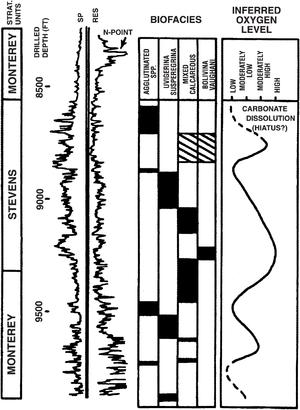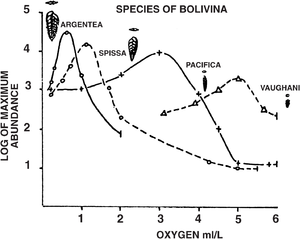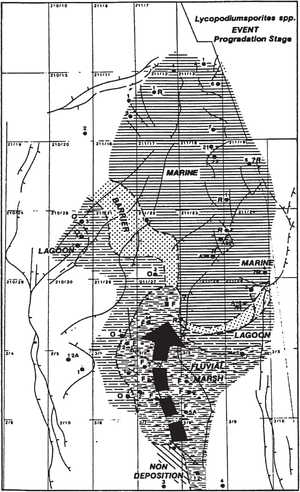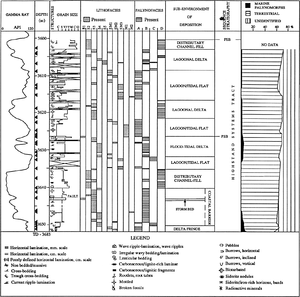Paleoenvironmental analysis
| Exploring for Oil and Gas Traps | |

| |
| Series | Treatise in Petroleum Geology |
|---|---|
| Part | Predicting the occurrence of oil and gas traps |
| Chapter | Applied paleontology |
| Author | Robert L. Fleisher, H. Richard Lane |
| Link | Web page |
| Store | AAPG Store |
The aim of paleoenvironmental analysis, or paleoecology, is to reconstruct the biological, chemical, and physical nature of the environment at the collection site at the time of deposition, based on the rock's paleontological record. Information can be reconstructed for depositional environments, paleobathymetry, positions of ancient shorelines, paleoclimate, degree of oxygenation of the bottom water and sediment, and salinity of the waters (see the articles on Paleoclimatology, Paleobathymetry, and Palynofacies and kerogen analysis).
Procedures
The three basic steps involved in paleoenvironmental analysis are data collection, data interpretation, and integration with other data sources.
Data collection
The kind of paleoenvironmental question to be answered determines the type of paleontological data that must be collected. The following table shows some questions asked and the data needed to answer them.
| Depositional environment/shoreline position | Presence, abundance, and relative species proportions of palynomorphs, foraminifera, and ostracods |
| Paleoclimate/paleoceanography | Species distribution and abundance of climatically or oceanographically sensitive fossils: calcareous nannofossils, planktonic and benthic foraminifera, spores and pollen (e.g., bisaccate conifer pollen, tropical angiosperm pollen), and oxygen isotope analysis of foraminifera |
| Oxygen and salinity | Occurrence and species distribution of foraminifera, ostracods, diatoms, and salinity-sensitive algae (e.g., Botryococcus, Pediastrum ) |
Data interpretation
Paleoenvironmental knowledge is established by (1) using the known tolerances of taxa or their nearest living relatives in modern environments and (2) studying the distribution of fossil taxa in well-controlled ancient examples. The data are interpreted on the basis of this established paleoenvironmental knowledge.
Examples of data interpretation

Traverse[2] provides a general review of the methods of palynological paleoenvironmental analysis. He discusses the use of palynomorphs as paleoclimate indicators and the methods by which sedimentation of palynomorph assemblages help infer depositional environments in both marine and nonmarine settings. Additionally, Lipps[3] provides a similar general review of paleoenvironmental approaches for micropaleontology. Following are three examples of paleoenvironmental information deduced from micropaleontology.
Species distribution and oxygen concentration
Lagoe[1] recognizes four biofacies of benthic foraminiferal species in the upper Miocene Stevens Sandstone of the southern San Joaquin Valley. He demonstrates that the biofacies distribution was largely controlled by changes in oxygen concentration caused by fluctuations in the position and intensity of low-oxygen water within the oxygen minimum zone.
In Figure 1, biofacies associations reflect different and distinctive populations living in different paleoenvironments. Biofacies are arranged from left to right in order of inferred increasing oxygen concentration. The stratigraphic distribution strongly suggests systematic shifts in oxygen concentration.
Test shape and oxygen concentration

Test morphologies of some closely related species of the foraminiferal genus Bolivina differ in patterns apparently related to oxygen concentration[4][5] in modern environments along the California continental margin. Compressed, relatively large species (B. argentea) are typical of low-oxygen environments.
In Figure 2, species inhabiting high-oxygen environments (e.g., shelf depth) are small, prolate forms; those in low-oxygen environments (e.g., basin depths) are large, lanceolate forms.
Distribution of palynomorph types

Whittaker et al.[6] provide an industrial example in the Brent Group (Jurassic), North Sea, in which the distribution of palynomorph types is used to infer the depositional environments and extent of delta progradation during brief intervals of the Jurassic. Figure 3 illustrates the nonmarine (fluvial and marsh), lagoon, barrier, and marine environments and the interpreted sediment transport direction (large arrow) during one time interval. This information can help identify regions of greater potential for fluvial reservoir sands.
Oboh[7] develops a paleoenvironmental model of Middle Miocene reservoir units from the Niger Delta, which uses palynomorphs and organic matter to interpret more precisely the depositional environments. This improves the understanding of the lateral continuity of the reservoir and its susceptibility to diagenetic changes.
Integrated paleoenvironmental interpretation
Figure 4 shows an integrated paleoenvironmental interpretation of the E2.0 reservoir (Middle Miocene, Niger Delta). Lithofacies range from pebbly sandstones (S1) to mudstones (M2). The palynofacies are composed of the following substances:

- Wood and amorphous organic matter
- Black debris (intertinite) and land plant resins
- Wood with slight amounts of amorphous organic matter
- Black debris with wood and amorphous organic matter
The paleoenvironmental interpretation should be integrated with interpretations based on other data sources (e.g., sedimentology well log analysis, seismic) and plotted on wells or cross sections.
Limitations
Paleoenvironmental analysis can be limited by the ambiguity of the paleoecological significance of the fossils recorded. In general, reconstructions of paleoenvironment become less precise and less reliable with increasing geologic age as the affinities of ancient to modern forms become very distant.
See also
- Applications of biostratigraphy
- Biostratigraphic correlation and age determination
- Paleobathymetry
- Quantitative paleoenvironmental analysis
- Palynofacies and kerogen analysis
- Thermal maturation
- Biostratigraphy in sequence stratigraphy
References
- ↑ 1.0 1.1 Lagoe, M. B., 1987, The stratigraphic record of sea-level and climatic fluctuations in an active-margin basin: the Stevens Sandstone, Coles Levee area, California: Palaios, vol. 2, no. 1, p. 48–68., 10., 2307/3514572
- ↑ Traverse, A., 1988, Palaeopalynology: London, Unwin Hyman, 600 p.
- ↑ Lipps, J. H., ed., 1993, Fossil Prokaryotes and Protists: London, Blackwell Scientific, 342 p.
- ↑ 4.0 4.1 Douglas, R., G., 1979, Benthic foraminiferal ecology and paleoecology: a review of concepts and methods, in Lipps, J., H., ed., Foraminiferal Ecology and Paleoecology: SEPM Short Course 6, p. 21–53.
- ↑ Douglas, R., G., 1981, Paleoecology of continental margin basins: a modern case history from the borderland of southern California, in Depositional Systems of Active Continental Margin Basins: Pacific Section of Society of Economic Paleontologists and Mineralogists Short Course Notes, p. 121–156.
- ↑ 6.0 6.1 Whittaker, M. F., Giles, M. R., Cannon, S. J. C., 1992, Palynological review of the Brent Group, UK sector, North Sea, in Morton, A., C., Haszeldine, R., S., Giles, M., R., Brown, S., eds., Geology of the Brent Group: Geological Society Special Publication 61, p. 169–202.
- ↑ 7.0 7.1 Oboh, F. E., 1992, Multivariate statistical analysis of palyno debris from the Middle Miocene of the Niger Delta and their environmental significance: Palaios, vol. 7, p. 559–573., 10., 2307/3514869